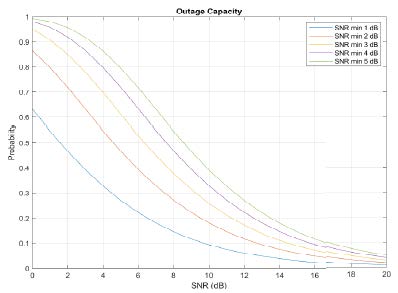Iskandar
Sekolah Teknik Elektro dan Informatika
Abstract
Low capacity and reliability are the challenges in the development of ionosphere communication channel systems. To overcome this problem, one promising and state-of-the-art method is applying a multicarrier modulation technique. In this research, we propose a multi-carrier modulation technique in combination with a model variation of Lowest Usable Frequency (LUF) and Maximum Usable Frequency (MUF) values as the main bandwidth to optimize the use of available channel capacity while also maintaining its reliability by following the variation of the ionosphere plasma frequency. To analyze its capacity and reliability, we performed a numeric simulation using a LUF-MUF model based on Long Short Term-Memory (LSTM) and Advanced Stand Alone Prediction System (ASAPS) in Near Vertical Incidence Skywave (NVIS) propagation mode with the assumption of perfect synchronization between transmitter and receiver with no Doppler and no time offsets. The results show the achievement of the ergodic channel capacity varies for every hour of the day, with values in the range of 10 Mbps and 100 Mbps with 0 to 20 dB SNR. Meanwhile, the reliability of the system is in the range of 8% to 100% for every hour of one day based on two different Mode Reliability calculation scenarios. The results also show that channel capacity and system reliability optimization are determined by the accuracy of the LUF-MUF model.
Keyword: ionosphere communication channel, capacity, reliability, multicarrier, LUF, MUF
Introduction
The main challenge of the ionospheric communication channel system is its low channel capacity and reliability. The low channel capacity is due to the multipath fading environment and the coherent bandwidth limitations. While the low-reliability main factor is caused by the boundary of the transmission frequency value, which follows the variation of the ionosphere plasma frequency. To overcome the low-capacity issue, a multi-carrier modulation technique such as Orthogonal Frequency Division Multiplexing (OFDM) is used as one of the solutions, with the purpose to avoid frequency selective fading

Research Method
The basic form of multi-carrier modulation is dividing the data stream into multiple sub-streams that are transmitted over different orthogonal subchannels centered at different sub-carrier frequencies. In this study, the proposed block diagram of the multi-carrier modulation technique with a combination of LUF-MUF variations in the ionosphere channel communication system is shown in Fig. 2. The data stream transmission is divided into an independent number of K sub-carriers, which are determined by the variations of LUF-MUF and Bandwidth coherent (Bc) values. The values of LUF-MUF and Bc are known on the transmitter and receiver sides.
The LUF and MUF values could be obtained from physics models such as the International Reference of Ionosphere (IRI), theAdvanced Stand-Alone Prediction System (ASAPS), and NeQuick that available for public uses. Those models are empirical models that were built using different methods but have a similar number of input variables, namely: location, time, and conditions of solar activity. In practice, more than one input variable could make the system more complex. The machine learning model could utilize a single variable of time series data. Therefore, the LUF-MUF model based on machine learning is simpler to practically apply in the proposed system. In this study, the LSTM machine learning model was used for the analysis beside the empirical physic model namely ASAPS.
- Scenario #1. Transmission fails completely if one or more of the sub-carriers cannot be realized, and
- Scenario #2. Transmission can still be realized with some degree of reliability, even if some sub-carriers cannot be realized.


Discussion & Result



Conclusion
The multi-carrier modulation technique, combined with LUF-MUF variation, is a promising method for improving the channel capacity while also maintaining the reliability of the ionospheric communication channel system. This method uses variations of LUF-MUF prediction values from a model as the main bandwidth and a Bandwidth coherent Bc value as the subcarrier bandwidth. Numeric simulation
using the ASAPS and LSTM models for the LUF-MUF values shows the achieved ergodic channel capacity varies in a range of 10 Mbps to 100 Mbps with SNR 0 to 20 dB.